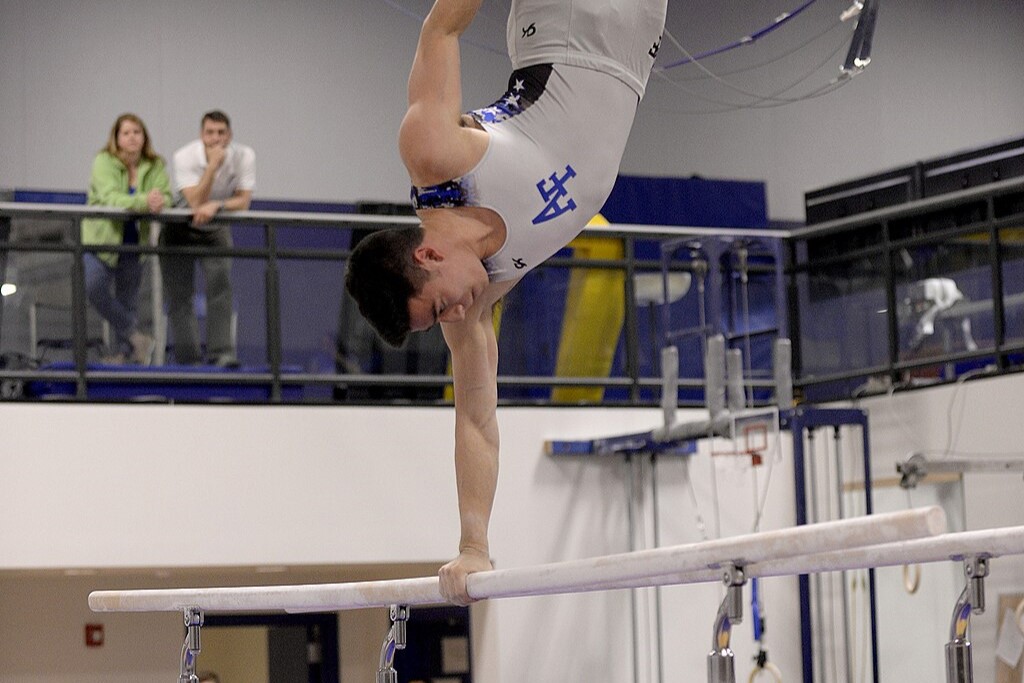Summary
In gymnastics, Parallel Bars routines feature complex swings, releases, and handstands performed on two parallel fiberglass rails. Scoring combines difficulty (D-Score) and execution (E-Score), with additional points awarded for specific skill groups, including upper arm, support, underbar, and dismount elements. Judges apply deductions for form errors and specific parallel bars mistakes.
An entertaining and favorite event to both watch and perform, the parallel bars are all about displays of high-flying and powerful gymnastics. In this overview of parallel bars, we will explain what the parallel bars are, judges evaluate pbar routines, and the various skills gymnasts perform on the apparatus.
What are the Parallel Bars?
The Parallel Bars, sometimes referred pbars, consist of two parallel “wooden” rails set at the same height, roughly 200cm above the floor typically, and set a little more than shoulder-width apart. These rails are supported by a metal base with 4 vertical supports.
Interestingly, these “wooden” rails aren’t actually wood anymore, but instead are made of fiberglass.
Key Characteristics of Parallel Bars Performances
The handstand is key for parallel bars, and most skills are continuous swings and releases performed to and from handstand.
Just like the horizontal bar, the PBars emphasize the principles of swing and flight while attempting to use the bounce of the two rails to generate power. Every skill on PBars involves support or hang from the arms, so it demands great upper body strength.
The nature of the event leads to many high-flying and complex skills. Currently, the code of points lists 176 skills on parallel bars. The large variety of difficult skills makes PBars a visually impressive event and is a favorite of many spectators and athletes.
How is PBars Scored?
Judges score Men’s Artistic Gymnastic routines with a difficulty score and execution score. Essentially,
The difficulty score, or D-Score, indicates how difficult the routine performed was.
The execution score, or E-Score, indicates how well the gymnast executed the routine.
Final Score = D-Score + E-Score
Evaluating Difficulty on Parallel Bars
Like the other events in Men’s Gymnastics, the eight highest-difficulty skills a gymnast performs in his routine count toward the D-Score.
The FIG code of points assigns a letter value to each skill indicating its how difficult it was. Each letter corresponds to a tenth value, as noted in the chart below.

In addition to skill value, gymnasts gain difficulty value by fulfilling compositional requirements called element groups. Fulfilling the element groups grants the gymnast +0.5 (five-tenths) to the D-Score. To fulfill an element group, a gymnast must perform a D-value element or higher from that group. But, if only a C or lower skill is performed, the gymnast receives partial fulfillment of +0.3.
What are the Element Groups on Parallel Bars?
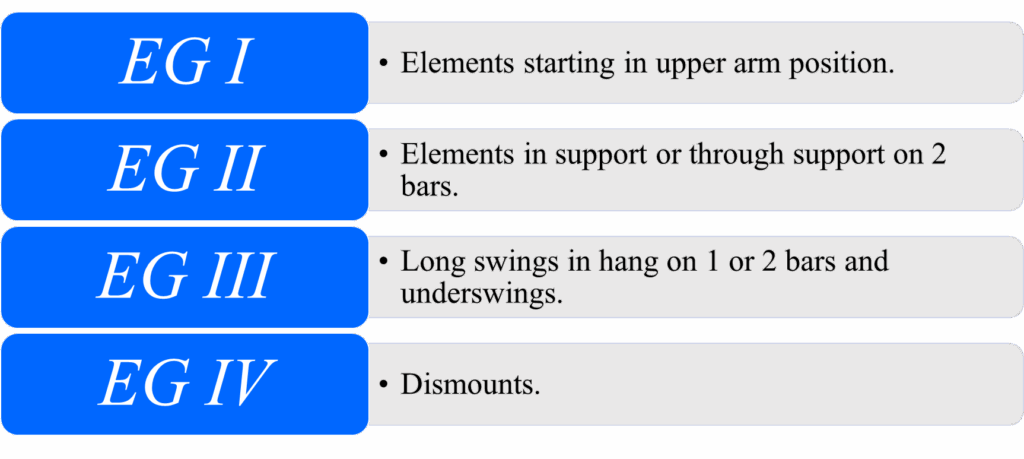
Element Groups In-Depth: Which skills fit in each Element Group?
EG I – Upper Arm
The upper arm element group consists of skills starting from support on the upper arms. In upper arm support, the arms will be bent around 90-degrees with the hands grabbing the bars and the biceps resting on top of the rails. The most fundamental upper arm skills are the front uprise and back uprise.
A front uprise (A) is a swing forward in upper arm, rising up to straight arm support in the front. The front uprise is often used as a setup for other support skills or dismounts that require a swing backward.
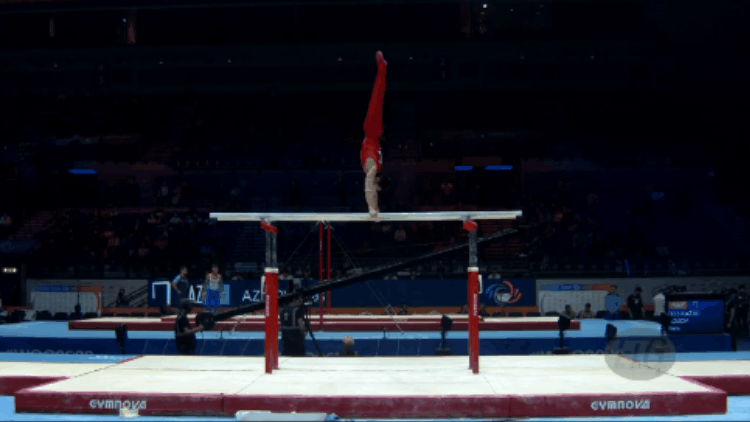
Source: FIG
A back uprise is a swing backward in upper arm, rising up to straight arm support in the back. Although the back uprise does not count as a skill for value, it is used in combo with other skills to produce higher value skills. For example, a honma / whippet (D) is a back uprise into a front toss – a fwd somersault from front support catching in back support.
EG II – Support
Support elements on parallel bars involve holding the body on top of the bar with just the hands on the rails and arms straight. Again, the handstand is vital to most skills in this element group.
Gymnasts commonly perform a few types of support skills in a routine. A pirouette (A) is a handstand with a half-turn. Gymnasts often do pirouettes to change directions or move into a better position on the bar and they are an important foundation for higher-level support skills involving turns.
One skill that a pirouette is useful for is a healy (D), where the gymnast starts performing a pirouette from a handstand but spins back, while reaching the arm backward into rear support to swing down. This will look like a full turn falling forward.
A diamidov (C) is the reverse, where the gymnast swings forward into a full turn on one arm finishing in a handstand. Also, finishing the diam on one bar or adding an extra half turn increases the difficulty value of the skill. A Stutz (C) starts like a diam, but the gymnast hops into a half turn to handstand instead of performing a full turn.
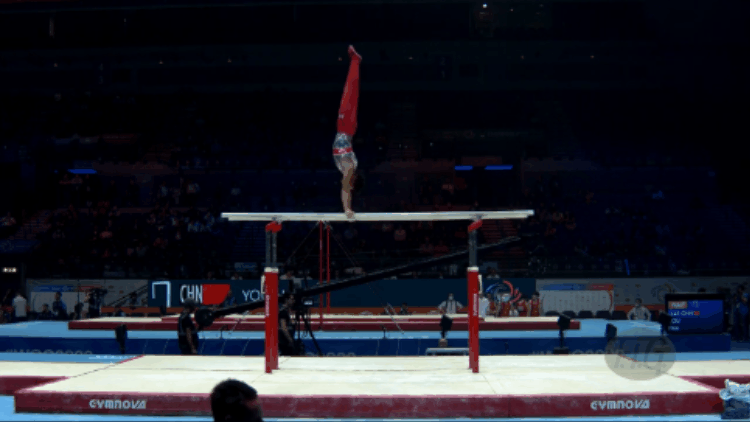
Source: FIG
EG III – Underbar
The underbar group consists of skills that hang and swing under the bar. Similar in principle to some high bar skills, many underbar skills also correspond with skills on high bar.
Long hang skills are a category of underbar elements. These involve hanging under the bar with the shoulders completely open and the arms by the ears. Something to note about long hang skills is that gymnasts may bend their legs once their body passes under the bars so they don’t kick the floor. Most gymnasts touch the floor with their legs when hanging with straight legs under the bar.
Just like high bar, gymnasts can perform giant swings on parallel bars, swinging from a handstand on two rails, down under the bar, and then back up to a handstand in an extended position.
A Moy involves swinging in a long hang, stopping the feet at horizontal in the front swing, then sitting up to regrasp the bar behind them in rear support. Sometimes gymnasts perform a Moy with a straight leg tap, called a Tippelt-tap. You can tell the Tippelt-tap when a gymnast goes from handstand into a long bowing arch while bailing away. They follow through with a strong kick forward under the bar to hollow before sitting up onto the bars.
The skill the tap is named after is the next progression of a Moy to support, the Tippelt (D).
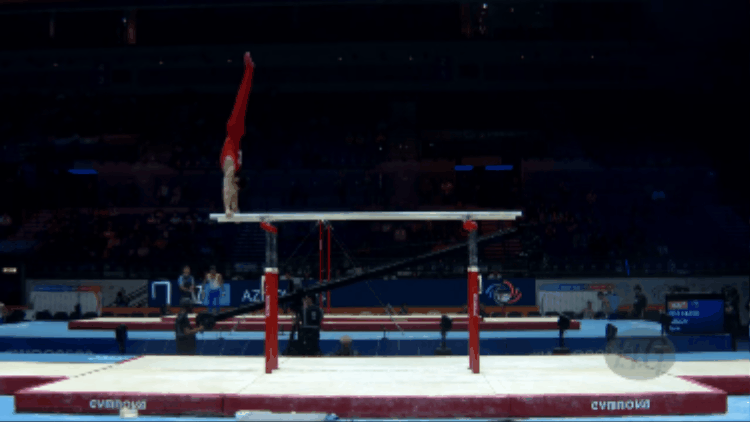
The Tippelt is very similar to a straight leg moy with a tap, except the gymnast will reach forward into straddle sit as they finish sitting up. If a gymnast’s tap and sit up are strong enough, they can perform a Bhavsar (E) where they start like a Tippelt but pass through straddle in the air before returning into long hang instead of support. These skills use the same actions as a Tkachev on the high bar.
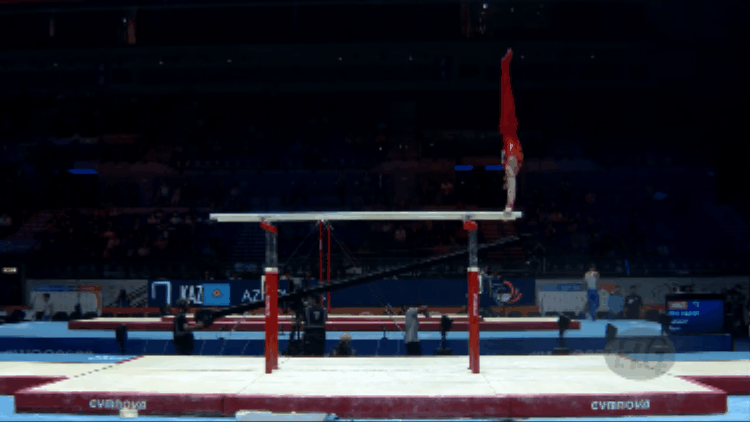
Source: FIG
Another common category of underbar skills is basket swings. These involve hanging under the bar upside down in a pike. The most simple basket is a drop cast, where the athlete will return go from basket swing up on top of the bar to upper arms. Another common skill is a peach basket (B), where the gymnast will circle back up to support on the bars from a basket swing. A Peach to Handstand (C) is just a bigger peach basket that circles up to a handstand instead of support.
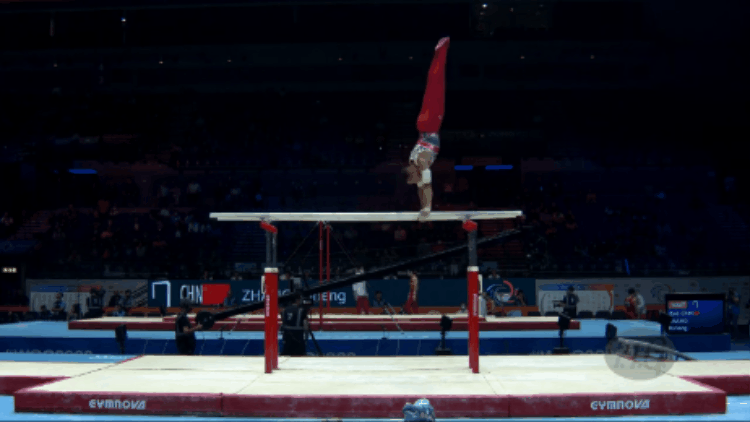
Source: FIG
EG IV – Dismounts
Dismounts are the last element group of parallel bars and they can be split into three different types: front, back, and long hang. Front and back dismounting by far are the most common dismounts with long hang flyaway dismounts fairly rare.
Front dismounts involve a front somersault off to the side of the bars from a support swing backwards. Gymnasts who prefer front dismount will frequently perform double front (E) dismounts.
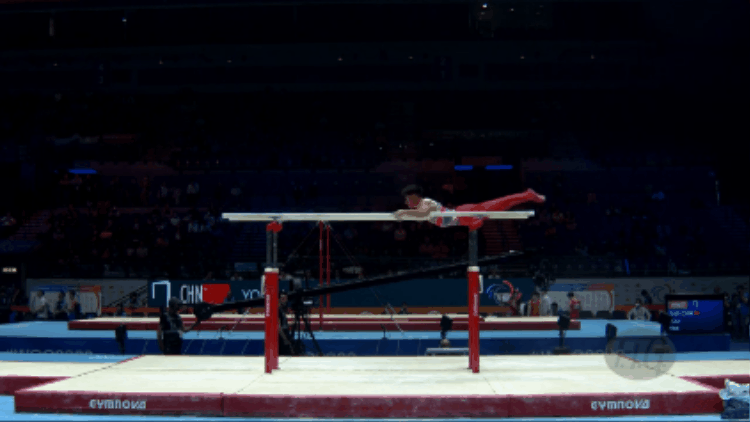
Source: FIG
In contrast, back dismounts involve a back somersault off to the side of the bars from a support swing forward. Gymnasts that prefer back dismounts often perform double back pike (D) dismounts.
Long hang flyways involve a back somersault off the end of the bars from a swing under the bar, but very few gymnasts perform them.
Unique Skills: Combining Elements
Makuts-style skills combine Diamidovs to one bar with Healy variations. A Makuts (E) itself is a 3/4 diam to one rail into a 3/4 Healy. Most Makuts elements come from EG II. However, some start from upper-arm and fit into EG I. An example of this is Tsolakidis 1 (G) which is a Makuts that starts from upper-arm support.
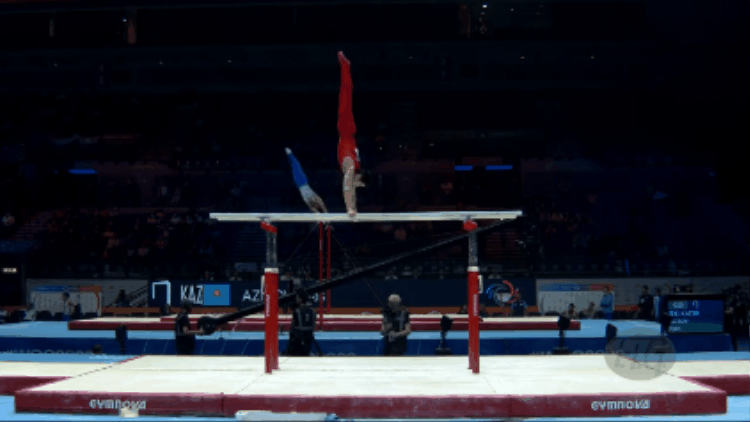
Giants also combine with diams, with a Giant Swing to Diam worth an E. Peach baskets also can be performed with turns, but they are not technically considered diams. Giants and baskets with turns fit into EG III.
And again, front uprises combine with diams. For example, the Richards (E) is a diam from a front uprise.
Parallel Bars Execution and Common Deductions
As with every event in men’s gymnastics, the E-Score starts at a 10.0 in gymnastics, and judges take deductions from there when gymnasts make mistakes in their routine.
Along with general form deductions that always apply, here is a list of parallel bar’s specific deductions:
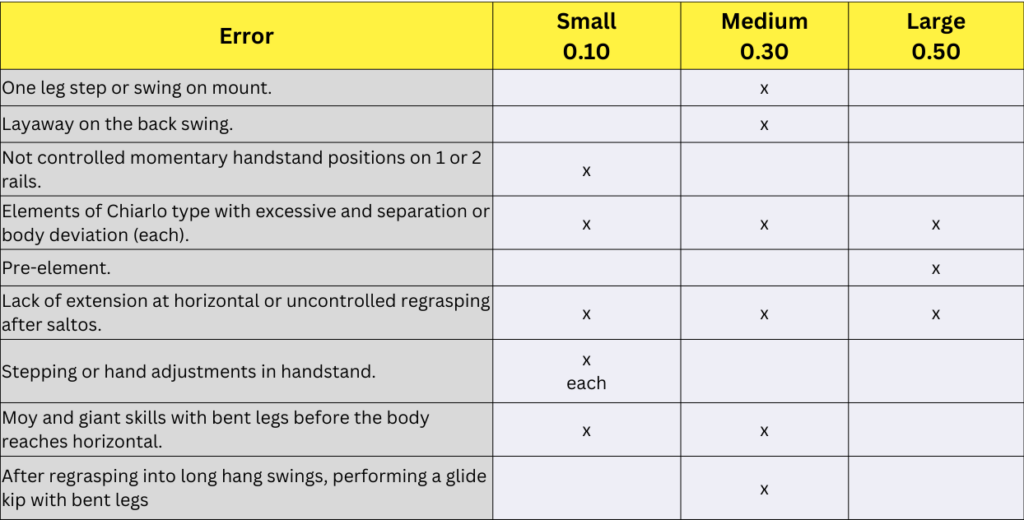
Special Expectations for Makuts Style Elements
Makuts skills (our diam to healy combinations) have a special rule about pauses. Makuts skills should not have a pause in handstand between the diam part and the healy part. Ideally, they flow one right into the other. The following chart indicates the deductions for pauses in a Makuts.

Final Notes
I hope this article has given you some insight into parallel bars performances and scoring. Feel free to comment with further questions and please share this post!
For another event overview of men’s gymnastics, check out our guide to pommel horse.

